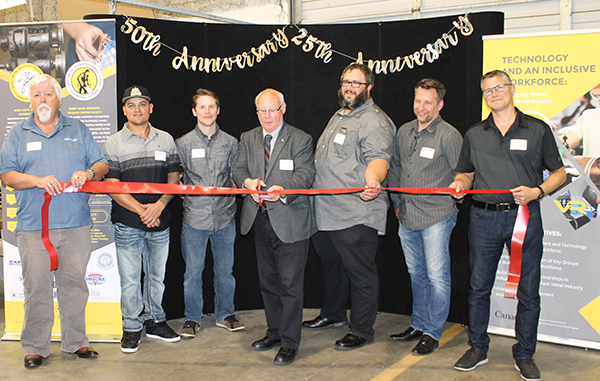
THE TRADES ARE EVOLVING.
By Jessica Kirby
Technology is slowly infiltrating this previously impervious industry, hinged on tradition and a “not broken, don’t fix it” ideology, and smart contractors and training centres are embracing the change. But it’s not just an eye to the future that will keep the sheet metal industry successful, says Jud Martell, training co-ordinator for the Sheet Metal Workers Training Centre (SMWTC). It will be a birdseye view of what is coming, what is current, and what has gone before that will ensure a solid foundation moving forward.
The SMWTC and the Sheet Metal Industry Training Board (SMITB) celebrated 25 and 50 year anniversaries, respectively, in September at an event held at the SMWTC. The celebration represented a visit through history, the present, and into the future and tied in the Centre’s newly announced Union Training and Innovation Program (UTIP).
UTIP is a federal cost-sharing initiative developed to increase investment in training equipment and materials for higher quality training, leading to a more skilled and productive trade’s workforce and improved participation and success of key groups in trades training and careers including women, Indigenous People, and newcomers to Canada.
For the SMWTC, UTIP means a number of goals and objectives (see sidebar) that will improve educational and recruitment opportunities. The program officially launched this summer with a presentation by Ken Hardie, Port-Kells MP, and a ribbon cutting ceremony was held at the anniversary, which also showcased the program’s new technologies.
The anniversary was organized around Passport Through Time activities that led attendees through the facility to visit eight stations presenting some aspect of the theme—the Past was represented by historical displays, the Present focused on shop curriculum and project showcases, and visitors glanced into the Future with opportunities to demo new technology and equipment.
Station #1, located in the office, covered the history of the centre and many of the people and projects that gave it its strong foundation. Guests milled out at this station looking to find themselves and people they know in photographic displays.
Station #2, set up at registration, featured boards outlining all of the connections that brought together and have continued to build the fabric of the SMWTC and SMITB—trustees, staff, instructors, and various supporters.
In the shop area, attendees found Station #3, which was the competition and project showcase and highlighted specialty training. Close by in the welding shop was Station #4, which was a close-up look at the SMWTC’s new welding equipment.
Up on the mezzanine at Station #5, Jake LeBlanc introduced visitors to the level three architectural sheet metal area where students learn the sheet metal and architectural curriculum.
The first station to showcase some of the UTIP technology was #6 where students learn to operate an aerial platform in a virtual environment. At Station #7 instructor Bob Pascuzzi went over some of the classroom and drafting theory, and at the final station, #8, visitors could see how students learn welding in an augmented reality simulation.
Guests had pass cards initialed for completing the activity or hearing the presentation at each station, and submitted the full card into a draw for some great door prizes. Congratulations to prize winners Donna Henderson from the Industry Training Authority and Martin Rachel from Crosstown Metal.
“I thought this was a great event,” says Dan Burroughs, retired sheet metal worker and former business agent for Local 280. “Everyone did a great job of presenting their station. I really enjoyed the virtual reality training, and I just loved looking at all the pictures—it brought back so many memories. Jud and team, well done.”
Into the Future
Martell says the UTIP project is a prime example of how the SMWTC is defining itself as a place where innovation is embraced and students are supported in being prepared for the future.
“We are trying to look into the future and recognize how things will be done differently in the world moving forward,” Martell says. “This technology is a part of that. I can imagine sitting around in 20 years and being surprised about what we didn’t see coming. Maybe by that time you will go to work in a clean room with clean tools where you walk in and fire up your augmented space or your virtual tools to drive the robots that do the actual work,” he says.
Virtual and augmented reality are different, Martell explains, because in the first the user is having an immersive experience in a completely contrived environment, and in an augmented reality the learning components are added to actual reality.
“When you look through the screen you can see the world,” says Martell of augmented reality. “When you turn on the machine, it adds the welding points, equipment, and materials to create welding situations in your real world.”
Knowing and understanding the technology is a key part of staying ahead of changes in the future, he adds. “Ours has traditionally been a reactive industry, but we’ve realized that if we don’t think about new technologies or solutions until the contractors mention it, by then someone else is probably already doing it. We need to understand that so we don’t just do work for today, but so we also have the resilience and critical thinking to apply skills to whatever is coming next.”
Looking back to the initial development of the SMWTC, Martell points out it was considered crazy talk to put one trade into its own training centre, even though it promised direct communication with and training of individuals in that trade.
“What are we doing today that the people doing the 75 year anniversary will tell stories about?” he adds. “What a great feeling at the end of this event to see that all the great work done by people who came before us has been recognized and not taken for granted.”
Creating and maintaining partnerships and community will be an important part of keeping the momentum going, and, speaking of technology, social media serves an important role in doing that, he adds.
“As an industry we are good at the person-to-person interaction, but as people who are looking to expand our networks and see what is going on outside our own doors it pays to be a part of a wider social presence. You might see something amazing going on in Arizona that is worth a share because they are still a partner and still part of our community.” ■
TECHNOLOGY AND AN INCLUSIVE WORKFORCE: FORGING OUR FUTURE SHEET METAL INDUSTRY WITH UTIP
The Technology and an Inclusive Workforce: Forging our Future Sheet Metal Industry Project has been developed to improve the success of sheet metal workers using new equipment and to address emerging technology trends in the sheet metal industry.
Funded through the Union Training and Innovation Program (UTIP), this federal cost-sharing initiative was developed to increase investment in training equipment and materials for higher quality training, leading to a more skilled and productive trades workforce.
UTIP is also intended to improve the participation and success of key groups in trades training and careers including women, Indigenous People, and newcomers to Canada.
Project Objectives:
- Purchase new equipment and technology to prepare a skilled workforce
- Increase representation of key groups to build an inclusive workforce
- Build broad-based partnerships to influence change in the sheet metal industry
- Assessment and reporting on results of the project
Project Goals:
GOAL #1:
SMWTCS students (apprentices and journeys) will have access to and benefit from training on the new equipment leading to a more technologically skilled workforce. The following equipment and technology will be purchased:
• Mobile elevated work platform simulator
• New welding machines
• Virtual reality/augmented welding technology
• Fan service equipment for new a specialty training course
GOAL #2
SMITB will develop recruitment strategies to build a more diverse and inclusive workforce by targeting key groups including women, Indigenous People, and newcomers to Canada. SMITB will build off their expanded partnerships to influence change in the sheet metal industry.
GOAL #3
SMITB, working in collaboration with the project evaluation consultant, will develop data collection systems and resources to support the assessment and reporting on results of the project.
UTIP Partners include:
SMACNA-BC
WorkBC
Industry Training Institute
SMART
VanCity
Downtown Custom Metal Works Ltd.
Constriction Foundation of BCBC Building Trades
ITA (Industry Training Authority)
PICS (Progressive Intercultural Community Services Society)



